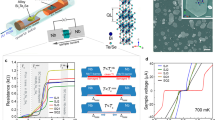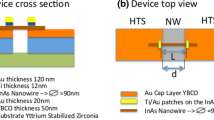We report on the fabrication and characterization of coplanar Pb–Cu–Pb nanobridges. In such superconductor (S) – normal metal (N) – superconductor junctions the Josephson coupling is mediated via the proximity effect at the S–N interface. For a junction in the dirty limit (ℓ≪ ξ N where ℓ is the mean free path and ξ N is the coherence length in N) the Josephson current I c is proportional to L/ξ N ·exp(−L/ξ N ). The relation defines an upper limit for the length L of the normal-metal bridge in order to observe Josephson coupling. A Josephson current of up to 750 μA at 1.5 K was observed in junctions with L/ξ N = 0.82 which is only 1/8 of the theoretically expected value. The reduction might originate from oxide layers at the normal metal – superconductor interfaces.
Similar content being viewed by others
References
Bardeen J., Cooper L.N, Schrieffer J.R, (1957). Phys. Rev. 108: 1175
Josephson B.D, (1962). Phys. Lett. 1, 251
Delin K.A, Kleinsasser A.W, (1996). Supercond. Sci. Technol. 9, 227
Likharev K.K, (1979). Rev. Mod. Phys. 51, 101
See special issue of Superlattices and Microstructures 25 (5/6), 627–1288 (1999).
Mesoscopic Electron Transport, L L.,. Sohn, L. Kouwenhoven, and G. Schön, (ed.) NATO ASI Series E 345, Kluwer Academic Publisher, Dordrecht (1997).
Deutscher G., and P. G. de Gennes, in “Superconductivity”, R. D. Parks, (ed.) Marcel , New York (1969), Vol. 2, p.1005.
de Gennes P.G., Guyon E., (1963). Phys. Lett. 3, 168
Likharev K.K, (1976). Sov. Tech. Phys. Lett. 2, 12
Due to space limitations in the immediate vicinity of the junction a two-leads geometry has to be used. The finite residual resistance at low T in Fig. 3 is caused by the resistance of the two leads of the 2-wire probe.
Andreev A.F, (1964). Sov. Phys. JETP 19: 1228
In the resistively- and capacitively-shunted junction (RCSJ) model the I−V curve becomes hysteretic for large enough C (see Ref. 13 for details). As a consequence the maximal supercurrent might be reduced, e. g. by thermal fluctuation effects. However, this effect plays a minor role for the data in this study.
Tinkham M., Introduction to superconductivity, McGraw-Hill International Edition, (1996).
Usadel K.D, (1970). Phys. Rev. Lett. 25, 507
Zaikin A.D, and Zharkov G.F, Sov. J. Low Temp. Phys. 7, 184 (1981); see also Ref. 16.
Dubos P., Courtois H., Pannetier B., Wilhelm F.K, Zaikin A.D, Schön G., (2001). Phys. Rev. B 63: 064502
G. Goll, Unconventional Superconductors, Springer Tracts in Modern Physics Vol. 214, Springer (2006).




